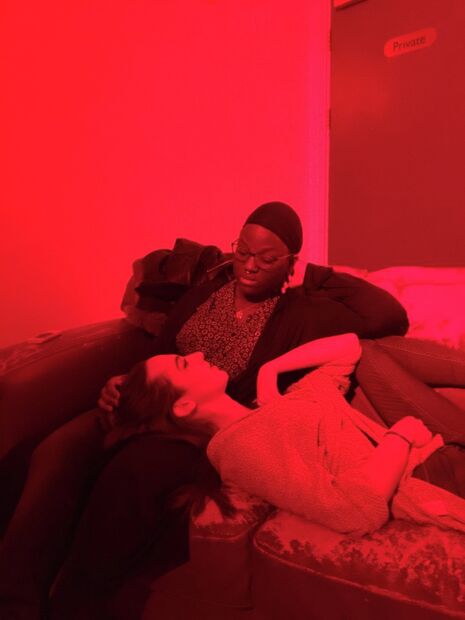Let’s Start A Fire review
This is ‘a slick new play, thought provoking in both its writing and performance, and well executed in terms of production.’ -

The Larkum studio is amber-lit and crackling, and uncomfortably warm; I don’t know if the latter is due to controlled heating, psychologically induced by the light and sound effects, or merely in contrast to the cold and rain outside. In any case, it feels appropriate, because I am here for a play about burning. Burning foxes, that is. Yes, Victor Rees’ new play, Let’s Start a Fire, is about burning foxes. It is also about trust, understanding, selfishness, bullying, public image, and viral internet culture, but it gets there by the gruesomeness of a video in which a young man starts a fire on an animal. This sickening side to the play only festers as events unfold, and by the end of Let’s Start a Fire we are questioning everything about the characters with whom we have spent the past hour.
"As Rees revels in the grotesque, his writing provokes audible discomfort even from this small audience"
Robin, the man who burned the fox, does not actually feature in the play; instead, we see his sister, Sam, their father, Terry, and Sam’s girlfriend, Emma. Emma is perhaps the character with whom we identify most, experiencing a range of emotions throughout the piece, from delight to discomfort, distrust, and disgust. These were portrayed beautifully by Orli Vogt-Vincent, whose strong performance of moral conflict anchored the piece. Even as we drift from relating to Emma, we can understand her motives and share in her concerns. The only aspect of the performance I felt was off the mark was the oddly flirty way in which Emma interacted with Terry. Terry, played by Christoph Marshall, is a junior officer in a section of the civil service dedicated to the environment; he is distressed by the video’s release, not for the sake of the fox so much as the ironic shade it throws upon his position, and the potential scuppering his career faces as a result. He proposes some questionable solutions with a strangely innocent charm. I surprised myself in sympathising with Terry, whose bumbling concern for himself is apparently modelled on Boris Johnson, because Marshall managed to play the caricature with enough naivety that I almost forgave his ignorance and self-serving motivations. Almost.
Sam, on the other hand, was entirely unsympathetic. At first, I was dubious about Sam’s tone; she repeatedly refuses to rise to Emma’s challenges and delivers lines which I felt should be instinctively angry or irritated with a smile – ‘is this an argument? I didn’t realise.’ It was grating. It is easy to be tempted to play arguments at high intensity, but Tyra Amofah-Akardom’s performance had just the right level of flat falsehood to be effective. Sam continues to play with Emma’s hair and assert her love even as the couple are at breaking point, and details like this underscore the manipulative and uncomfortable aspects of the relationship suggested by Rees’ script. Credit must go to director Zara Ramtohul-Akbur for choosing to embrace this disjunction, which paid off. Other directorial decisions were good, too. The set was minimal but effective, and the conceit of the TV interviews was well achieved, though the radio section was hard to follow, largely because Amofah-Akardom and Vogt-Vincent have similar enough accents to be difficult to distinguish.
Let’s Start a Fire is a slick new play, thought provoking in both its writing and performance, and well executed in terms of production. The script itself is sophisticated and successful; Rees builds a variety of concerns around the central problem of the crime and how it got out. That event itself is a powerful springboard; as Rees revels in the grotesque, his writing provokes audible discomfort even from this small audience. We wanted to turn away, or to make it stop, but we were equally compelled to hear, and it is this compulsion which Rees exploits so effectively. Pushing at the boundary between the magnetism of the macabre and the horror of what has actually happened here (and I hope we can all agree that setting fire to a fox is horrible), Rees forces us to question where we would draw the line. Yet the skill of this play is not in the ostensible issue of animal abuse, though it is clearly an important one, but in the subtle workings beneath it. While we do get answers to the plot’s central questions – Who took the video? Who put it online? Why? – we certainly leave with more questions about the human potential for cruelty.
 Features / Should I stay or should I go? Cambridge students and alumni reflect on how their memories stay with them15 December 2025
Features / Should I stay or should I go? Cambridge students and alumni reflect on how their memories stay with them15 December 2025 News / Dons warn PM about Vet School closure16 December 2025
News / Dons warn PM about Vet School closure16 December 2025 News / Cambridge study finds students learn better with notes than AI13 December 2025
News / Cambridge study finds students learn better with notes than AI13 December 2025 News / News In Brief: Michaelmas marriages, monogamous mammals, and messaging manipulation15 December 2025
News / News In Brief: Michaelmas marriages, monogamous mammals, and messaging manipulation15 December 2025 Comment / The magic of an eight-week term15 December 2025
Comment / The magic of an eight-week term15 December 2025










